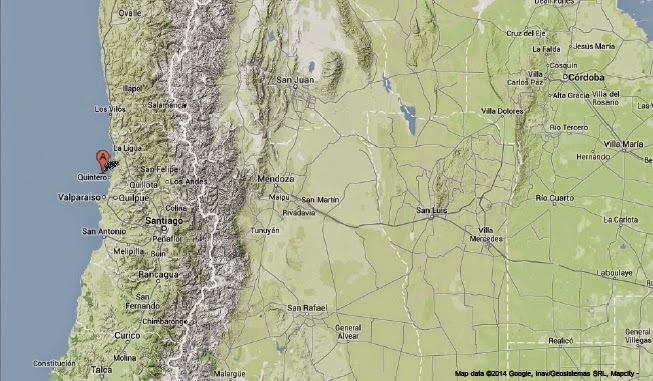Authorities in Chile have began to evacuate people from the vicinity of Volcán Villarrica, following a major eruption overnight between Sunday 1 and Monday 2 March 2015. Villarrica is active at some level more-or-less all of the time, but in mid February the level of activity began to rise sharply, leading to the Chilean National Service of Geology and Mining raising of the alert level around the volcano on Sunday. This was followed by a sharp rise in activity overnight, with material being thrown up to 600 m from the crater of the volcano and a sharp rise in Earthquake activity.
Volcanic activity on Volcán Villarrica. 24 Horas.
The volcanoes of Chile and the Andean region of South America in general are fed by the subduction of the Nazca Plate beneath the South American Plate along the Peru-Chile Trench, which lies offshore parallel to the west coast of South America. As the Nazca Plate sinks it is melted by the heat of the Earth's interior, and the lighter portions of it rise up through the overlying South American Plate to form volcanoes at the surface. These are dotted throughout the Andes Mountains; a range of mountains that is formed by a mixture of volcanism and crumpling of the South American Plate where is is forced against the Nazca Plate.
The subduction of the Nazca Plate beneath the South American Plate. Marot et al. (2012).
Volcán Villarrica is the westernmost of three volcanoes lying on the Gastre Fault Zone (the other two being Quetrupillán and Lanín, which are far less active) which runs toughly northwest-southeast, cutting across the Liquiñe-Ofqui Fault, which runs north-south along the Chilean Andes, and upon which the majority of the country's volcanoes sit. The Gastre Fault Zone is thought to be part of the ancient Lanalhue Fault Zone, which formed along an ancient subduction zone during the Permian (about 300-250 million years ago), during the assembly of the ancient supercontinent of Pangea.
The locations of the Gastre Fault volcanoes, Villarrica (green), Lanín (orange) and Quetrupillán (red). Google Maps.
See also...
The Projecto Observación Visual Volcán Villarrica recorded incandescence (glowing) around the crater of Volcán Villarrica, an active volcano in southern Chile, overnight between 4 and 5 February 2015. On 6 February tephra (hot fragmentary material) was observed being ejected from the crater, reaching...
The United States Geological Survey recorded a Magnitude 4.9 Earthquake at a depth of 51 km roughly 35 km to the west of Ovalle in the Coquimbo Region...
The United States Geological Survey recorded a Magnitude 5.1 Earthquake at a depth of 22.6 km, roughly 10 km offshore of the Chilean City of Quintero...
Follow Sciency Thoughts on Facebook.






